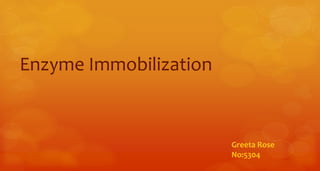
Enzyme Immobilization Techniques and Applications
- 2. It is the imprisonment of a biocatalyst in a distinct phase that allows exchange with, but is separated from bulk phase in which substrate molecules are dispersed and monitored They are immobilized on to an inert and insoluble matrix, under mild and controlled conditions where it can act upon its natural substrate. The matrix is usually a high molecular polymer such as polyacrylamide, cellulose, starch, glass, beads etc.. First reported in 1916 by J.M Nelson and E.G Griffin Reported the adsorption of invertase on charcoal without loss of activity Technique was developed in 1960s
- 3. An ideal matrix should have the following characters: • Low cost • Inertness • Physical strength • Stability • Regenarabillity after the usefull lifetime of the enzyme. • Enhancement of the enzyme specificity. • Reduction in microbial contamination and non specificic adsorption.
- 4. Advantages Repeated use of the enzyme as the recovery of enzyme molecules are easy More stability and reaction potential than free enzymes Enzyme –substrate ratio is high Less chance of contamination so pure products are obtained. Better efficiency Less labour intensive Minimum reaction time The cell free reaction system acts as model for studying the enzyme action of living cells
- 5. Disadvantages Causes additional cost Adversely affects activity , stability and the catalytic properties of enzymes. Suitable immobilization protcols are to be standardized for each enzyme. It becomes difficult when any of the substrates is insoluble.
- 6. METHODS OF IMMOBILIZATION Adsorption Covalent bonding Entrapment Liposomal entrapment Membrane confinement Cross linking
- 7. Adsorption Immobilized by physical adsorption to several types of materials. Adsorption due to electrostatic forces, hydrophobic interaction ,hydrogen bonds between atom and ions of carrier and enzyme. Commonly used matrices are ion exchange matrices ,porous carbon, clays, hydrous metal oxides, glasses and polymeric aromatic resins. Adsorption is done at appropriate pH and ionic strength Enzyme loading rate is 1gm enzyme/ 1 gm matrix
- 8. Covalent bonding Enzyme matrix molecules are attached to the carrier by formation of covalent bonds so that there is no loss of enzyme during use. Covalent bond formation occurs with the side chain of aminoacids of the enzyme Hydroxyl and aminogroups are the important ones involved in bonding Commonly used matrices are agarose,cellulose and polyacrylamides Enzyme loading is low ie 0.02 gm /gm matrix.
- 10. Entrapment Enzyme molecules are physically entrapped within a cross linked matrix of water soluble polymer. Polyacrylamide gel ,cellulose triacetate ,agar and gelatin are commonly used. Enzyme molecules are immobilized by the polymerization of polymer around the enzymes. Polymerization happens either with covalent bonding or without covalent bonding Enzyme loading is 1gm /g gel
- 11. Liposomal entrapment Liposomes are lipid bodies consisting two layers of lipids They are effective systems for enzyme microencapsulation owing to their ability to contain water-soluble enzymes within their aqueous confinement Phosphatidylcholines are the (phospho)lipids most commonly used for liposome preparation The appropriate lipids are dissolved in an organic solvent, which is subsequently eliminated under reduced pressure, leaving a thin lipid layer on the walls of the flask. This is dispersed with the prepared enzyme solution and liposomes containing the enzyme form spontaneously.
- 13. Membrane confinement Membrane confinement or encapsulation is a method of enzyme immobilization by entrapping method A droplet of aqueous solution of enzyme is enclosed in a semipermeable membrane capsule. It doesn’t allow escape of enzyme molecules. The semipermeable membrane capsule is made up of cellulose nitrate and nylon. Size of the pores of the membranes are too smalll ,therefore no free diffusion from membrane takes place. This method is cheap and simple Effectiveness depends on the stability of enzyme.
- 15. Co-polymerization Enzymes are immobilized by cross linking between the enzyme molecules through a polyfunctional reagent. Polyfunctional reagents include gluteraldehyde , diazonium salt, hexamethylene di-isocyanite and ethylene bismaleimide. There is no support or matrix used in this method This method is cheap and simple but are not frequently used as it may denature the enzymes leading to the loss of catalytic properties. This method is used in commercial and industrial applications
- 16. Effect of immobilization on enzymes Kinetic behaviour of an enzyme differ significantly from that of free enzyme molecules. Different enzymes respond differently to the same immobilization protocol. The effects on enzyme kinetics will be due to influence of matrix cor due to confirmational changes . When immobilization produces a strain in the enzyme molecules they become prone to inactivtaion by high temperature or Ph If immobilization is done without any strain , it leads to substantial elongation
- 17. Applications Immobilized enzymes are used in fermentation industry,agriculture,environmental protection. High fructose corn syrup is produced by the immmolbilized glucose isomerase from Actinoplanes misouriensis ,Basillus coagulans and Streptomyces etc. Raffinase activity is provided by the immobilized cells of the mould Mortierella vinacea. Immobilized invertase is used to produce sugar Lactase from Kluyveromycus lactis is immobilized in cellulose triacetate fibers , and are used in processing of milk and sweet whey.
- 18. Immobilized Penicillin amidases from E.coli are used in the production of penicillin, cephalosporins and other drugs. Immobilized microbial enzymes are used in agriculture for enhancing their activity without being affected by biotic or abiotic factors. Immobilizes bacteria,fungi and algae re used for removing heavymetal and radionucleotide waste from atmosphere.
- 19. ENZYME PROCESS L-amino acid oxidase Aminoacid production Flavoprotein oxidase Oxidation of drugs containing hydrazine groups Steroid hydrogenase Production of prednisolone Ribonuclease Nucleotide production from RNA Lipases Hydrolysis of oils,cocoa,butter Tannase Hydrolysis of tannins Protease Hydrolysis of whey proteins,cheese Pectinase Fruit juice treatment Urease Estimation of urea Thermolycin Production of aspartame(substitute for sugar)